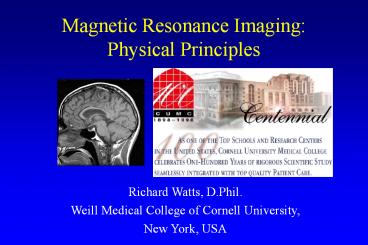Magnetic Resonance Imaging: Physical Principles - PowerPoint PPT Presentation

Magnetic Resonance Imaging: Physical Principles
Description:
Magnetic Resonance Imaging: Physical Principles Richard Watts, D.Phil. Weill Medical College of Cornell University, New York, USA Physics of MRI, Lecture 1 Nuclear . – PowerPoint PPT presentation
Number of Views:719
Avg rating: 3.0/5.0
Slides: 36
Provided by: Rich320
Learn more at: http://faculty.etsu.edu
Category:
Tags: imaging | magnetic | physical | principles | resonance
Transcript and Presenter's Notes
Title: Magnetic Resonance Imaging: Physical Principles
- Richard Watts, D.Phil.
- Weill Medical College of Cornell University,
- New York, USA
- Nuclear Magnetic Resonance
- Nuclear spins
- Spin precession and the Larmor equation
- Static B0
- RF excitation
- RF detection
- Spatial Encoding
- Slice selective excitation
- Frequency encoding
- Phase encoding
- Image reconstruction
- Fourier Transforms
- Continuous Fourier Transform
- Discrete Fourier Transform
- Fourier properties
- k-space representation in MRI
- 2D Pulse Sequences
- Spin echo
- Gradient echo
- Echo-Planar Imaging
- Medical Applications
- Contrast in MRI
- Bloch equation
- Tissue properties
- T1 weighted imaging
- T2 weighted imaging
- Spin density imaging
- Examples
- 3D Imaging
- Magnetization Preparation
- Chemical Shift and FatSat
- Water/Fat Separation
- Inversion Recovery and T1 Measurement
- Double Inversion Recovery
- Imaging blood flow
- Time-of-Flight
- Phase Contrast
- Fast Imaging
- Spoiling
- Spin Saturation
- Ernst angle, signal and contrast levels
- Spatial encoding
- Its all done with gradient fields
- Spatially varying Larmor precession frequency
- Slice select
- Frequency encode
- Phase encode
- Tissue contrast
- Different magnetic properties of tissues
- Different relaxation times
- T1 Longitidunal relaxation constant
- T2 Transverse relaxation constant
- Scan Parameters
- TE Echo time
- TR Repetition time
- Instead of exciting a thin slice, excite a thick
slab and phase encode along both ky and kz
- Greater signal because more spins contribute to
each acquisition
- Easier to excite a uniform, thick slab than very
thin slices
- No gaps between slices
- Motion during acquisition can be a problem
- Contrast-enhanced MRA of the carotid arteries.
Acquisition time 25s.
- 160x128x32 acquisition (kxkykz).
- 3D volume may be reformatted in
post-processing. Volume-of-interest rendering
allows a feature to be isolated.
- More on contrast-enhanced MRA later
- Precession frequency depends on the chemical
environment e.g. Hydrogen in water and hydrogen
in fat have a ?f fwater ffat 220 Hz
- Single voxel spectroscopy excites a small (cm3)
volume and measures signal as f(t). Different
frequencies (chemicals) can be separated using
Fourier transform
- Concentrations of chemicals other than water and
fat tend to be very low, so signal strength is a
problem
- Creatine, lactate and NAA are useful indicators
of tumor types
- Use a small bandwidth (long, 20ms) 90º pulse to
excite only protons within fat
- Destroy the transverse magnetization by dephasing
(spoiling)
- Not spatially selective no gradients
- Useful for reducing the fat signal in abdominal
and breast imaging
- Cost extra acquisition time
- After 180 inversion pulse the longitudinal
relaxation Mz grows back towards its equilibrium
value, M0
- Mz 0 when e-t/T1 ½
- T T1.ln2
- Select the inversion time, TI to null out the
required signal
- Image using different inversion times (TI) until
the signal is minimized
- Signal ? Mz(TI)
- Measure signal as a function of echo time, TE
- Spin echo sequence gives T2 (irreversible)
- Gradient echo sequence gives T2 (reversible and
irreversible)
- With two inversion pulses at appropriate times,
two tissue types can be nulled out
- e.g. CSF and fat in the brain
- Fast imaging TRltT1, T2
- Spins do not fully recover after each repetition
- Magnetization producing MR signal decreases with
the number of pulses until equilibrium reached
- Spins flowing into the slice have not seen
previous excitations, so have greater signal
- With a given gradient field, stationary spins
precess at a constant rate
- Moving spins experience a change in precession
frequency, depending on their velocity v, and the
gradient strength, G.
- This causes a velocity-dependent phase shift, ?f
- For constant flow velocity,
- With an x-Gradient Gx, the field strength is
- The phase shift is linear with velocity
- Add bipolar gradient in the flow direction after
RF excitation
- Stationary spins are not dephased
- Repeat acquisition with reversed gradients
- Complex subtraction of images gives flow image
- Fast imaging TRltT1,T2
- Spins do not have time to relax between one RF
pulse and the next
- Transverse magnetization Spin memory produces
artifacts in images. Many RF pulses contribute
to each acquisition
- Longitudinal magnetization Spins get beaten
down so that after each pulse there is less
magnetization available.
- Equilibrium between pulses and relaxation
- Optimum angle to maximize steady-state signal
Ernst angle
- Destroy transverse magnetization so it doesnt
contribute to later echoes
- Dephase the spins with large spoiling gradients
after each acquisition
- Assume perfect spoiling
- At equilibrium full magnetization is available
- Each pulse and spoiling reduces the magnetization
- Some signal regrowth due to T1 decay


